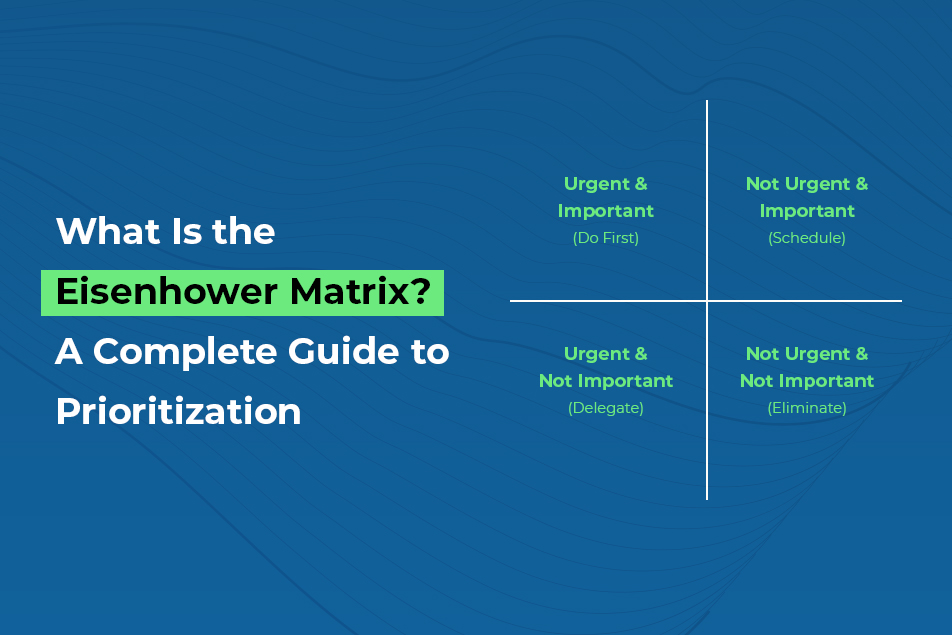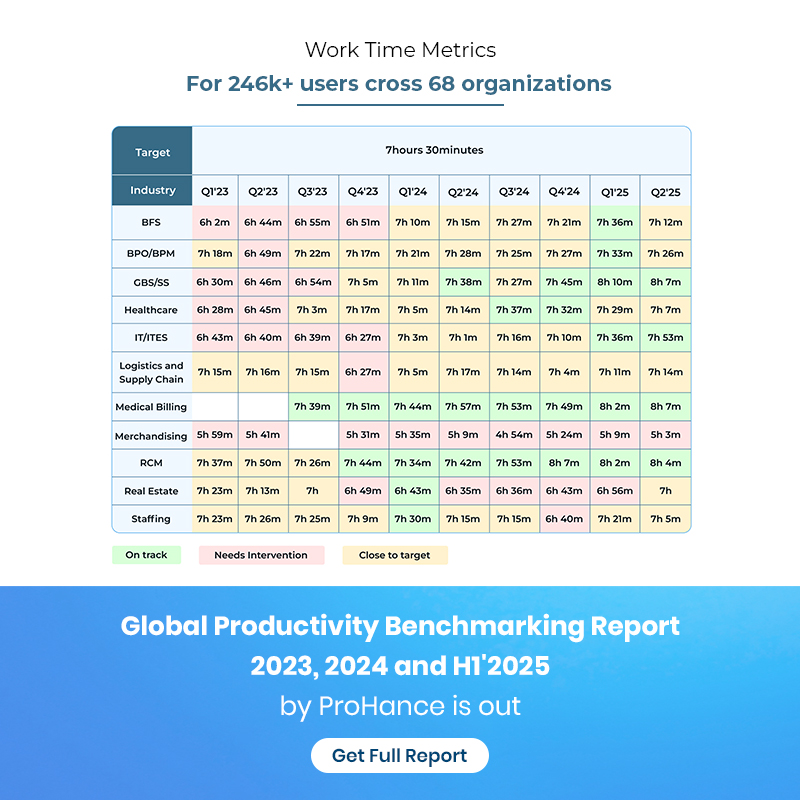What Is the Eisenhower Matrix? A Complete Guide to Prioritization
Table of Contents
“What is important is seldom urgent, and what is urgent is seldom important.”- President Dwight D. Eisenhower.
Every professional knows the feeling: staring at a never-ending task list while notifications ping constantly in the background. Deadlines compete for attention, meetings pile up, and somewhere between answering urgent emails and attending “quick” calls, the day disappears without much meaningful progress.
This struggle isn’t uncommon. Research shows that 35% of employees consider time management their biggest productivity hurdle, while nearly half report being productive less than 75% of their working hours.
These numbers reflect the necessity of having the right framework to separate what matters from what merely demands attention. And that’s where President Dwight D. Eisenhower’s observation laid the groundwork for one of the most practical prioritization tools available today.
The Eisenhower Matrix
This straightforward framework divides tasks into four categories based on two simple questions: Is this urgent? Is this important? The resulting grid creates a clear visual guide for decision-making that cuts through the noise of competing priorities.
The urgent, important matrix works because it addresses a fundamental human tendency—our instinct to react to whatever feels most pressing, regardless of its actual significance. This Eisenhower method shifts focus from reactive task-switching to strategic thinking about where time creates the most value.
When professionals apply Eisenhower matrix time management principles consistently, they often discover that many “urgent” tasks are simply loud distractions masquerading as priorities.
The Four Categories That Change Everything
Do First: Urgent and Important Tasks
The key characteristic here isn’t just time pressure—it’s that delaying action creates serious consequences. A missed project deadline with contractual penalties fits this category. A colleague asking for a quick favor usually doesn’t.
Most professionals should aim to minimize time spent in this quadrant through better planning and prevention, though some urgent-important tasks are simply part of business reality.
Schedule: Important but Not Urgent Tasks
This quadrant holds the secret to long-term success. Strategic planning, skill development, relationship building, and system improvements all live here. These activities don’t scream for attention but create the foundation for future achievements.
Research suggests that professionals who deliberately allocate time to this quadrant experience less stress and achieve better long-term results than those who constantly operate in crisis mode.
Delegate: Urgent but Not Important Tasks
These tasks create the illusion of productivity while consuming valuable time. They feel important because someone needs them done quickly, but they don’t require specific expertise or directly contribute to core objectives.
Examples include routine administrative work, certain types of meetings, and requests that others can handle effectively.
The challenge lies in recognizing when urgency doesn’t equal importance and building systems to handle these tasks without personal involvement.
Delete: Neither Urgent nor Important Activities
Every professional has activities that somehow consume time without adding value. Social media scrolling during work hours, excessive news checking, gossiping sessions, and poorly planned meetings often fall into this category.
Eliminating these activities entirely may seem harsh, but time is finite. Every minute spent on meaningless tasks represents time not available for activities that actually matter.
Implementing the Framework Step by Step
Start With a Complete Task Inventory
List everything currently competing for attention. Include projects, ongoing responsibilities, requests from others, and personal professional development goals. Don’t filter during this stage—capture everything, creating mental noise.
Create the Visual Framework
Draw a simple grid with “Urgent/Not Urgent” across the top and “Important/Not Important” down the side. Physical paper often works better than digital tools for this initial sorting process.
Sort Without Overthinking
Place each task in its appropriate quadrant based on honest assessment. If something feels difficult to categorize, it likely belongs in quadrant two or three—truly urgent-important items are usually obvious.
Take Action Based on Placement
- Handle quadrant one items immediately or schedule them for the earliest possible time
- Block calendar time for quadrant two activities and treat these appointments as non-negotiable
- Identify team members or systems that can handle quadrant three tasks
- Eliminate quadrant four activities entirely
Review and Adjust Regularly
Tasks shift between quadrants as circumstances change. Weekly reviews help maintain accurate prioritization and prevent important work from becoming urgent through procrastination.
ProHance: Supporting Smart Prioritization in Remote Teams
Remote work adds complexity to prioritization challenges. Without physical presence, managers struggle to understand how team members spend their time, while employees may lack clarity about priority alignment across distributed teams.
ProHance addresses these challenges through comprehensive productivity tracking and analysis:
| ProHance Feature | Prioritization Benefits |
| Time Tracking | Shows actual time allocation across different activities, revealing gaps between intended priorities and reality |
| Activity Monitoring | Identifies time spent on low-value activities (quadrant four) that could be eliminated or minimized |
| Productivity Analytics | Highlights peak performance periods for scheduling high-importance work (quadrant two) |
| Team Collaboration | Facilitates effective delegation by providing transparency into team capacity and capabilities |
| Performance Dashboards | Visualizes progress on strategic objectives, ensuring quadrant two work receives adequate attention |
| Automated Reporting | Eliminates manual administrative tasks, moving routine reporting from quadrant one to automated processes |
| Remote Work Insights | Provides managers with visibility into distributed team productivity without micromanagement |
The Bigger Picture Impact
Organizations that embrace structured prioritization methods report measurable improvements in both individual and team performance. Recent data indicates that workdays have become 15% shorter while maintaining productivity levels when systematic approaches replace reactive task management.
Beyond efficiency gains, professionals using frameworks like the Eisenhower Matrix often report reduced stress levels and increased job satisfaction. The clarity that comes from knowing what truly matters creates psychological relief that extends beyond work hours.
The matrix doesn’t eliminate difficult choices or competing priorities. Instead, it provides a consistent framework for making those choices consciously rather than reactively. Over time, this shift from reaction to intention becomes a valuable professional skill that compounds career growth.
Frequently Asked Questions
How long does it take to see results from using the Eisenhower Matrix?
Most people notice immediate clarity in daily decision-making, though developing the habit of consistent matrix thinking typically takes 2-3 weeks. Significant productivity improvements usually become apparent within a month of regular use.
What happens when everything truly is urgent and important?
This situation often indicates underlying planning or resource allocation issues. Step back and examine whether some “urgent” items could have been anticipated earlier or if workload expectations need realistic adjustment through conversations with supervisors or clients.
Can this framework work for teams with different priorities?
Teams benefit from discussing what “important” means in their specific context and aligning on shared definitions. Individual matrices can coexist with team-level prioritization when everyone understands the broader organizational objectives.






